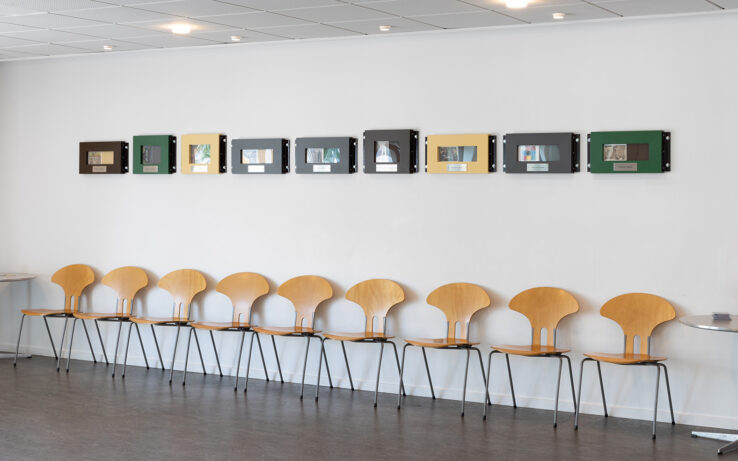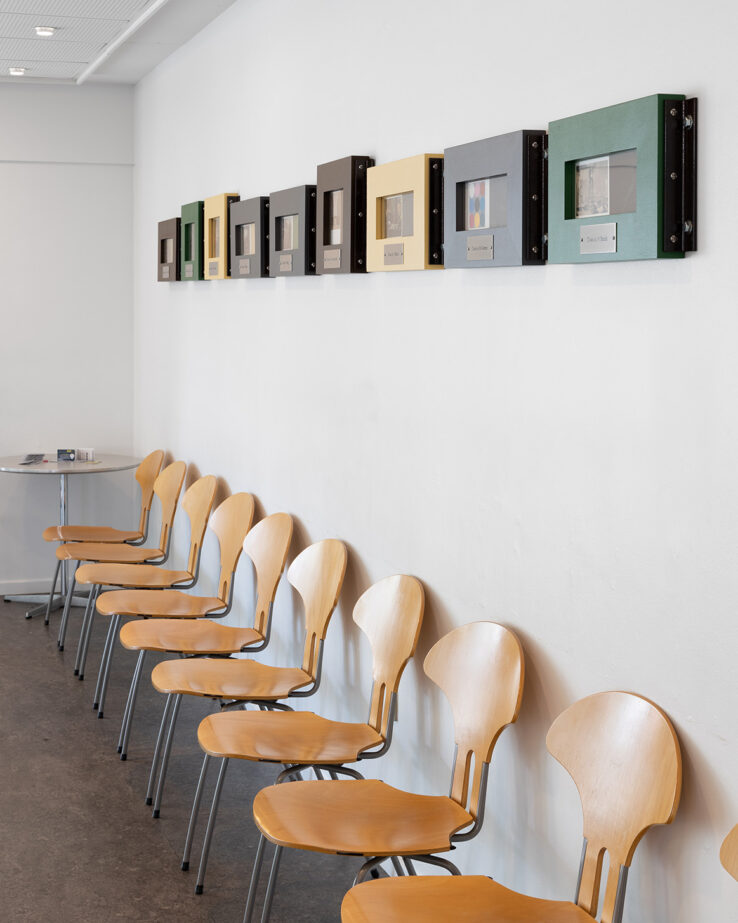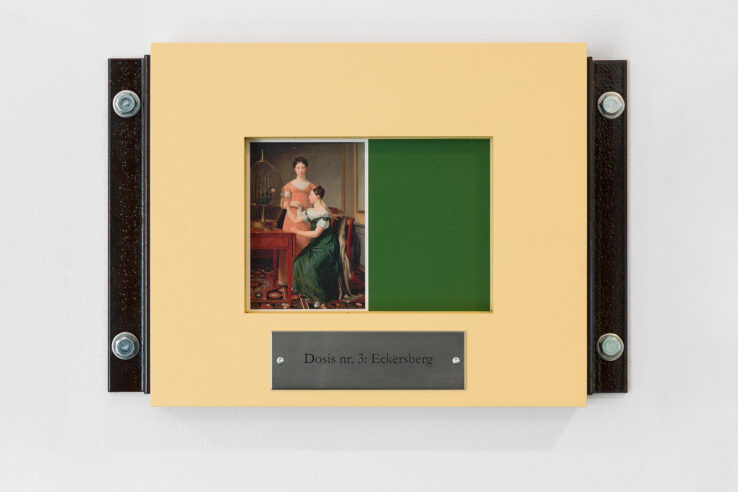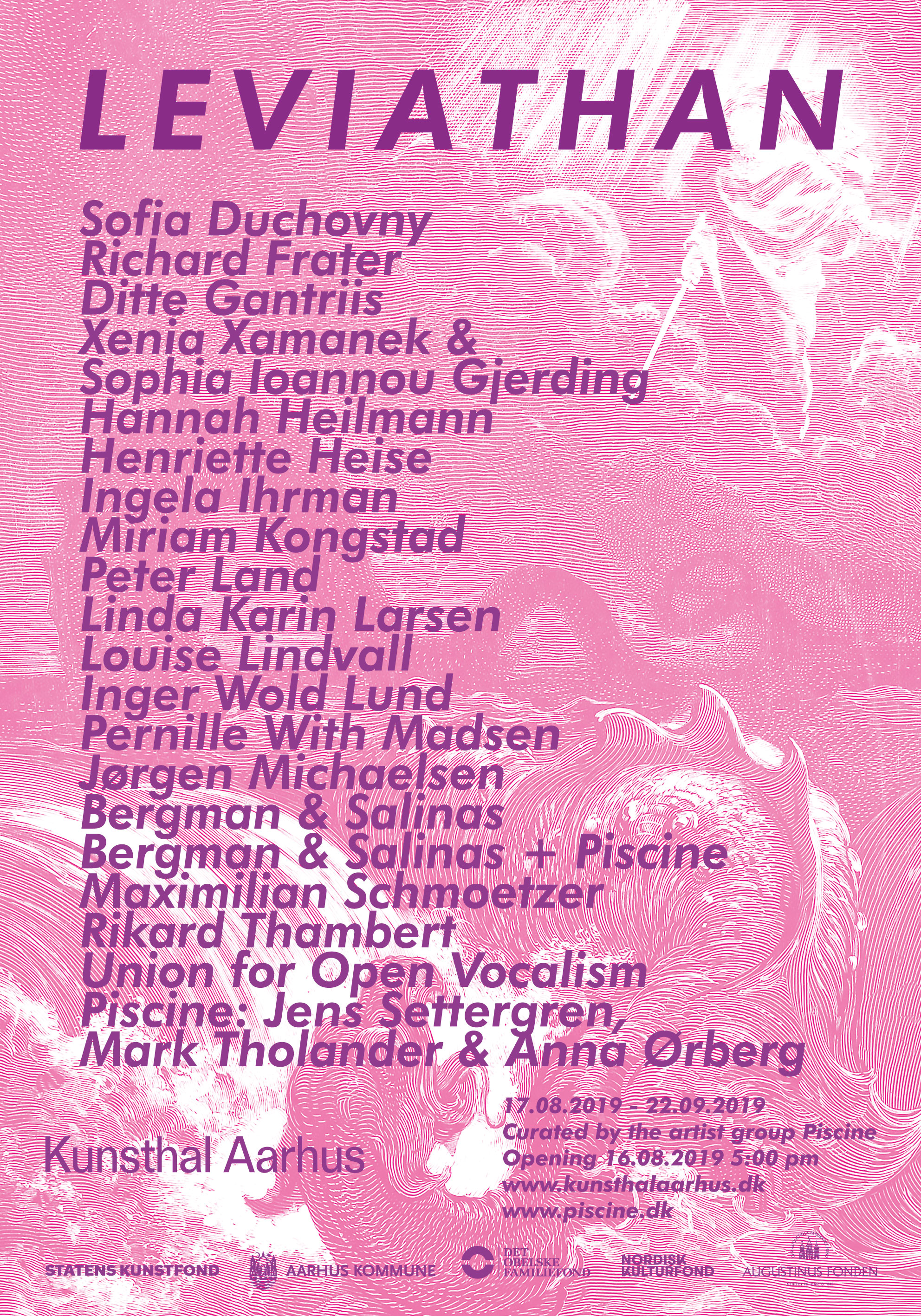
Overview
Leviathan was an exhibition taking place at various locations in Aarhus city centre: Aarhus Police Station, The Botanical Garden, Radisson Blu Hotel, Scandinavian Center, Lille Torv and Kunsthal Aarhus. The artistic interventions explored the relation between the public and the private, subjectivity and mass, the collective imaginary and behavioral patterns in our society. The works challenged codes and laws inscribed in our surroundings, critically processing and experimenting with the concepts of society, culture, nature and body.
Exhibition period: 16.08.2019 – 22.09.2019.
Leviathan was curated by the artist group Piscine.
During Leviathan, Piscine was Jens Settergren, Mark Tholander & Anna Ørberg.
Leviathan was created in collaboration with Kunsthal Aarhus.
This project has been supported by: Statens Kunstfond, Aarhus Kommunes Kulturudviklingspulje, Det Obelske Familiefond, Nordisk Kulturfond, Augustinusfonden and Radisson Blu Hotel.
Concept
At one point in the videogame The Dig (an adventure game developed by LucasArts in 1995) you face a frustrating challenge: in front of you is a scenario of scattered bones and you will have to assemble them into a skeleton in order to continue. The pieces must become a recognizable body. The problem is that you are on a foreign planet and have therefore never seen the being you are trying to assemble. The being whose body you will have to put together belongs to the unknown, and it is unclear whether you are to assemble at random, or if there is some kind of logic behind the task.
In the biblical stories the Leviathan is described as a sea monster that needs to be tamed. The figure is also known from Thomas Hobbes’ politico-philosophical magnum opus, Leviathan, from 1651. Here it is an image of society, the citizens being its body and the State its head. In the book Hobbes describes how the State can protect the citizens from the unpredictable State of Nature. According to Hobbes, the citizens make a deal with the State, giving up freedom in exchange for safety, and become part of one collective body.
How does it affect the individual being embedded in the macrostructures of society? How does society act upon that, which steps outside of the recognizable? Is the Leviathan a recognizable body or is it an assembly at random? And where is the exit?
Press
Contemporary Art Daily: https://www.contemporaryartdaily.com/2019/09/leviathan-at-kunsthal-aarhus/
Kunstkritikk: https://kunstkritikk.dk/efterarskarussel/
Aarhus Stiftstidende: https://stiften.dk/artikel/se-dem-ude-i-byen-s%C3%B8uhyret-har-vokset-sig-til-et-monster
Works
Ditte Gantriis
Title: Circle of Life (2018)
Location: Café area, Kunsthal Aarhus
Ditte Gantriis’s birthing woman in ashwood is surrounded by massive symbolism. With culturally coded elements like the rose leaves that above all point to love and desire, the well-crafted sculpture presents a fetishized and hyperromantic image of the woman as mother. Gantriis appropriates signs and symbols and combines them in ways that make them appear both genuine and ironic. With Circle of Life Gantriis examines how symbols are valorised and consumed within our culture.
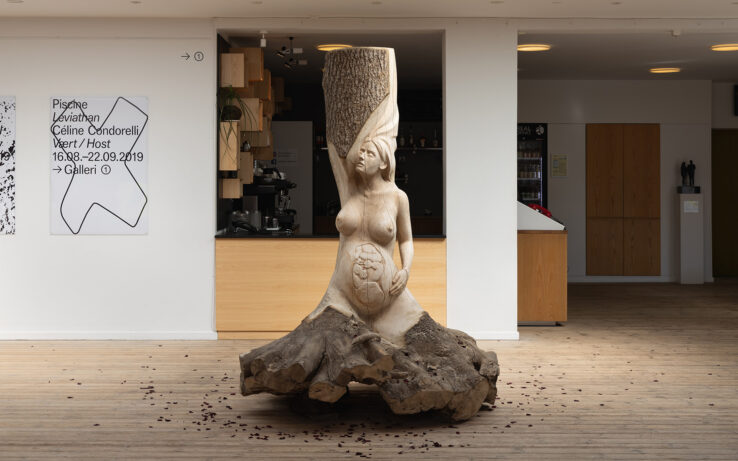
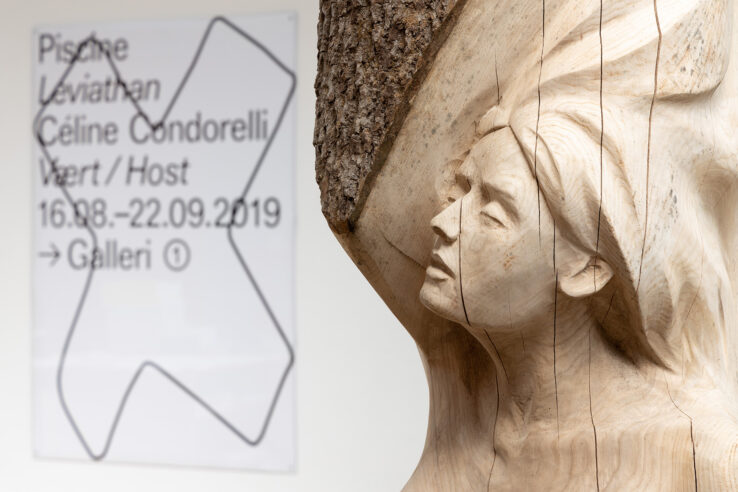
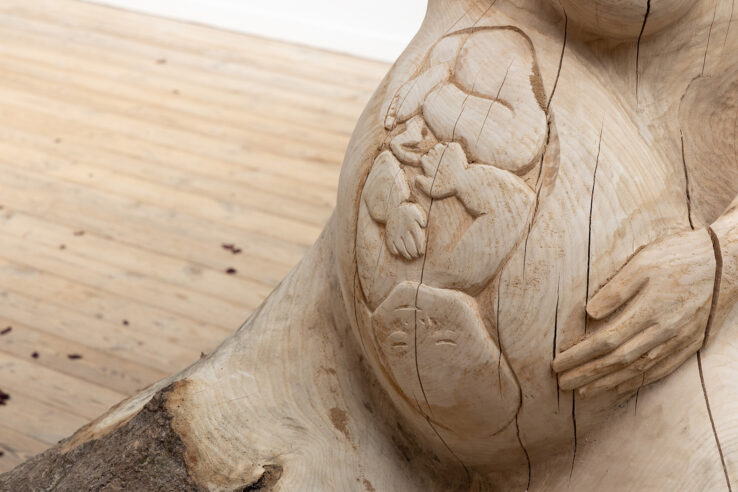

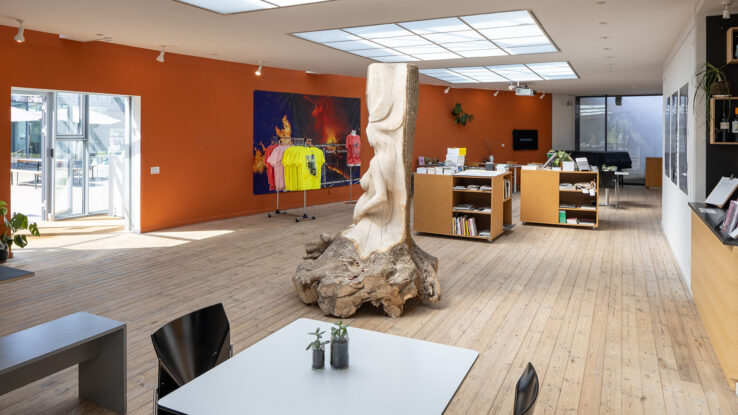
Bergman & Salinas + Piscine
Title: A Wildfire’s Desire Lines (2019)
Location: Café area, Kunsthal Aarhus
A Wildfire’s Desire Lines is a clothing line developed as a collaboration between the artist group Piscine and the artist duo Bergman & Salinas. The clothing line can be purchased by the visitor at Kunsthal Aarhus, placing the work somewhere in between an artwork and a commodity. The clothing line connects wildfires caused by climate change with burning institutions such as the National Museum of Brazil, Glasgow Academy of Fine Arts and the Notre Dame Cathedral.
The aesthetics of burning distributed through mass media images can be said to normalize the consequences of climate change by reducing it to isolated burning events that we can enjoy from a distance by video and photography. Media images are corporate images that determine public perception. Climate change has been embraced by the insurance industry, but not by the overall capitalist powers. There is both a physical and a metaphorical fire everywhere.
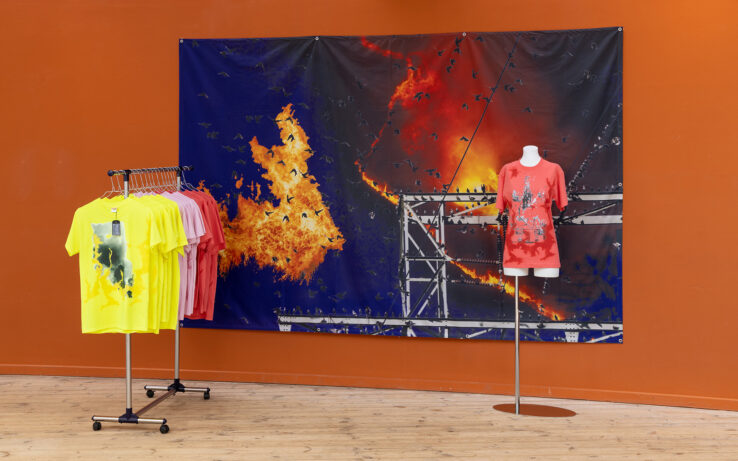
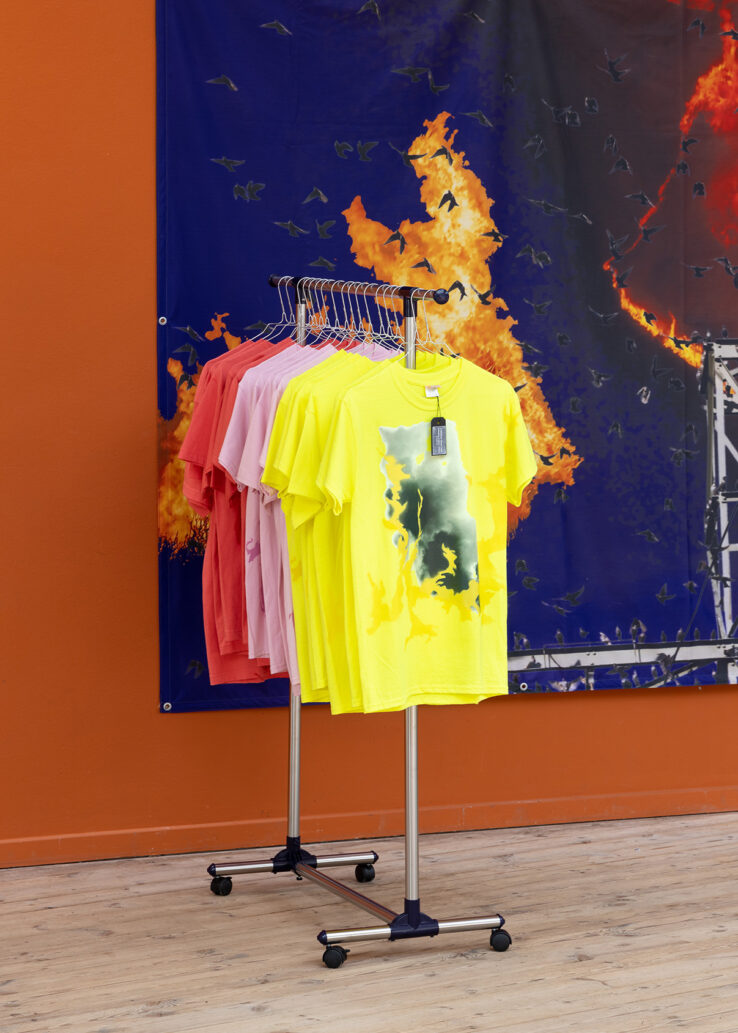
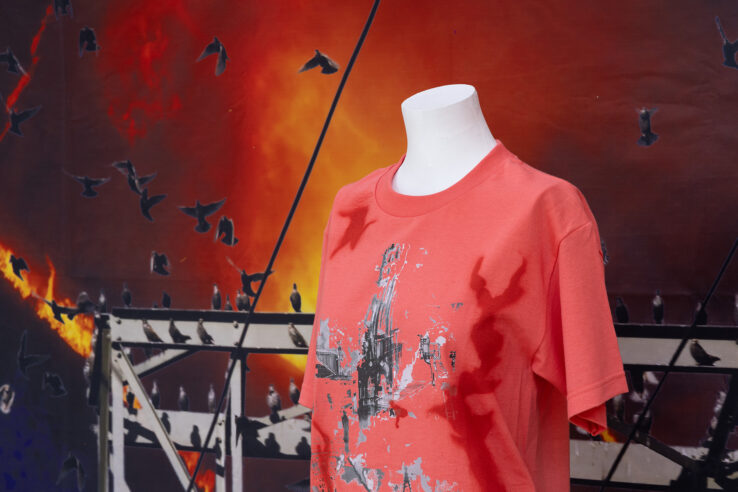
Miriam Kongstad
Title: Bloom of Flesh (2019)
Location: Café area, Kunsthal Aarhus
For centuries hair has been a globally sensitive and controversial topic. Scientific research shows that the hair on the head is a fundamental marker for decoding and recognition between individuals. Bloom of Flesh is a series of digitally manipulated images transferred to aluminium. Every piece consists of intertwining photos of the same person, all taken within a few minutes. The pieces simultaneously portray movement and a physicalization of mental states. The depicted bodies are disturbing, mutating, dissolving and flourishing. As a recurring element through the pieces the hairless wick suggests deindividualization, uniformation and institutionalization of the portrayed bodies. At the same time the bodies appear vulnerable and intense by virtue of their direct poses for the camera.
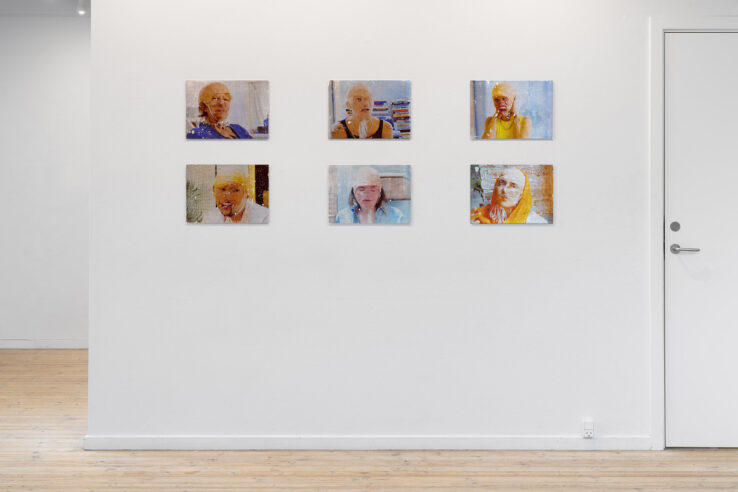
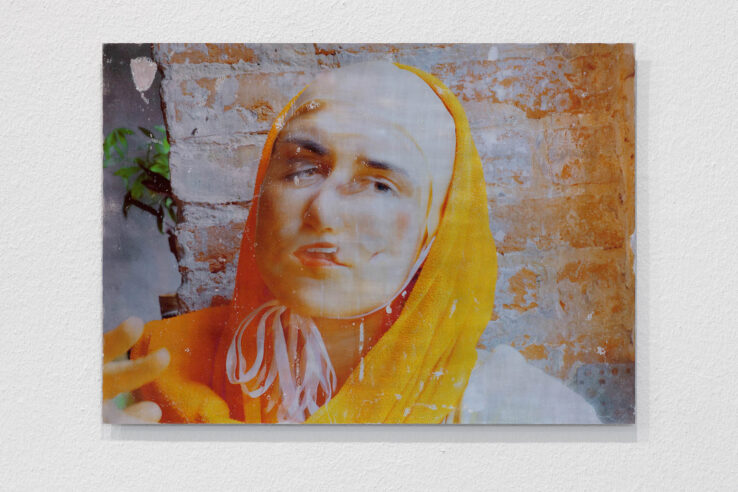
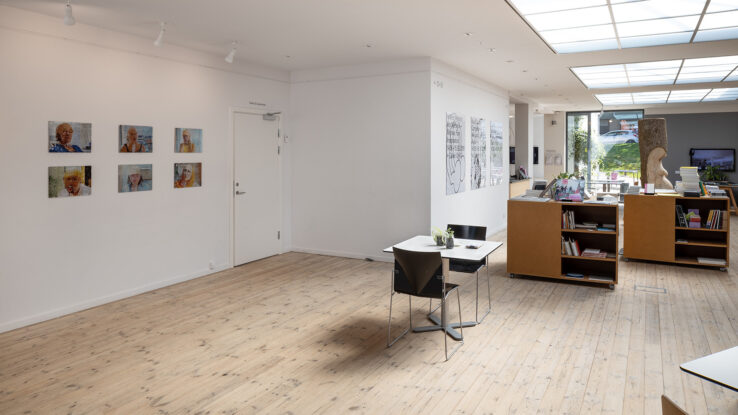
Inger Wold Lund
Title: Alone or with machines (2019)
Location: Cafeen, Kunsthal Aarhus
Inger Wold Lund has created a site-specific audio walk for Aarhus city centre. The audio walk is a tactile experience in which personal stories are linked to the streets of the city and to the people who move through the public space. It is not an audio walk in the touristic sense, but an opportunity to experience the city with another voice in the head than your own. The audio walk deals with our relation to machines and questions our interaction with them, including how we more often touch the machine, than each other. The work focuses on who we are in the encounter with the machine and how the machine affects our encounter with one another. Alone or with machines opens up the possibility of a new way of seeing what you perhaps usually miss and of looking at what you see every day. The sound of the audio walk is produced in collaboration with Brendan Howell. Devices for listening can be found in the café in Kunsthal Aarhus.
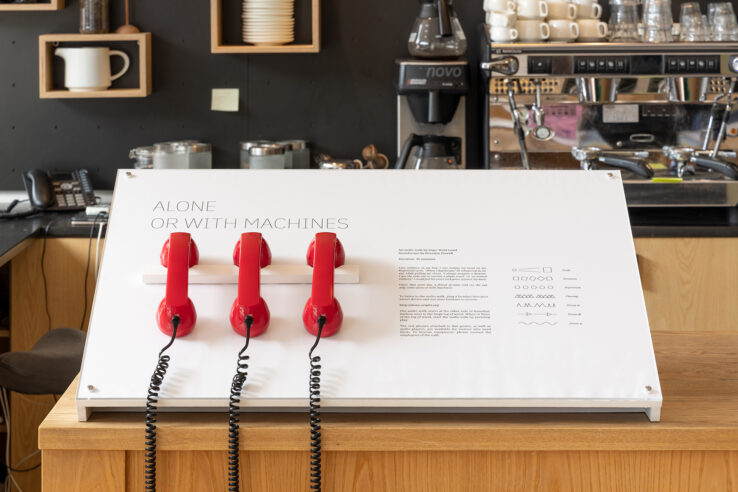

Xenia Xamanek & Sophia Ioannou Gjerding
Titel: ALVA II (2019)
Lokation: Gallery 1, Kunsthal Aarhus
ALVA II is an audio and video installation by artist duo Xenia Xamanek and Sophia Ioannou Gjerding. ALVA II deals with the voice as a prosthetic element separated from the body. In ALVA II we follow Mlle. Mlle is a voice that travels in a ghost box. A ghost box is a device for communication with other dimensions and a medium through which voices without bodies can speak. Mlle travels through various scenarios. Mlle encounters hosts, shells, ghosts, vocal tracts, other objects and other voices. They sing, speak, hum and cry through ghost boxes. Throughout Mlle’s journey romances and sorrow exist in songs and voices. Some voices flies freely, others are trapped in loops of tears. Mlle is a voice. When Mlle travels, Mlle flies. When Mlle rests, Mlle rests in a ghost box.
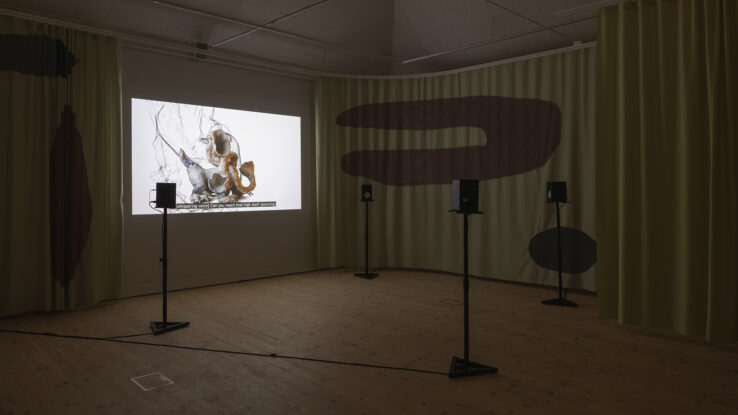
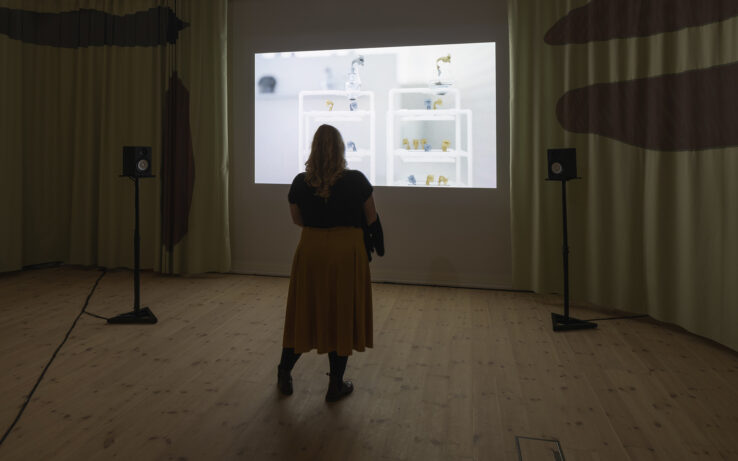
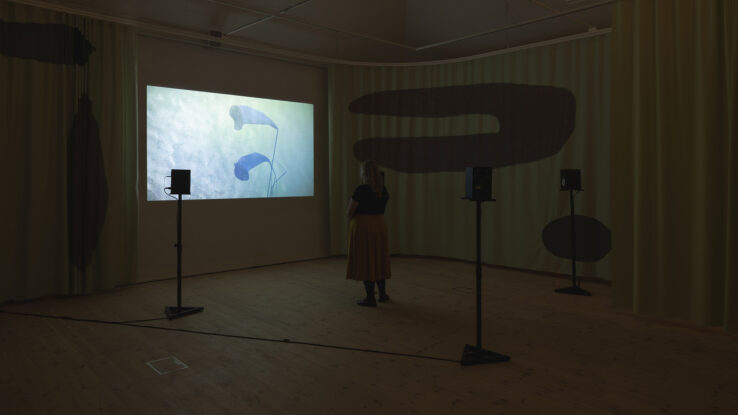
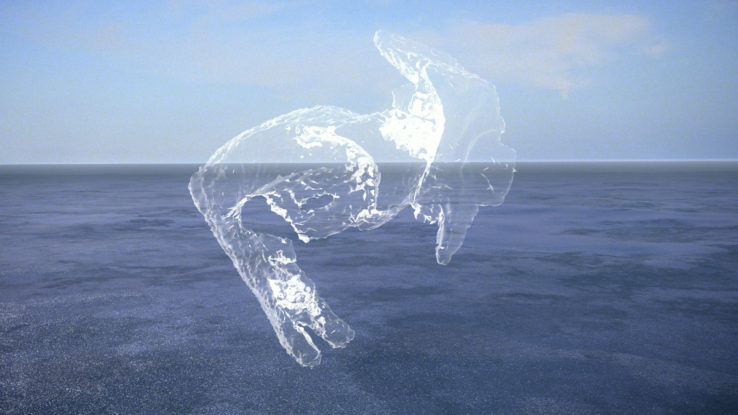

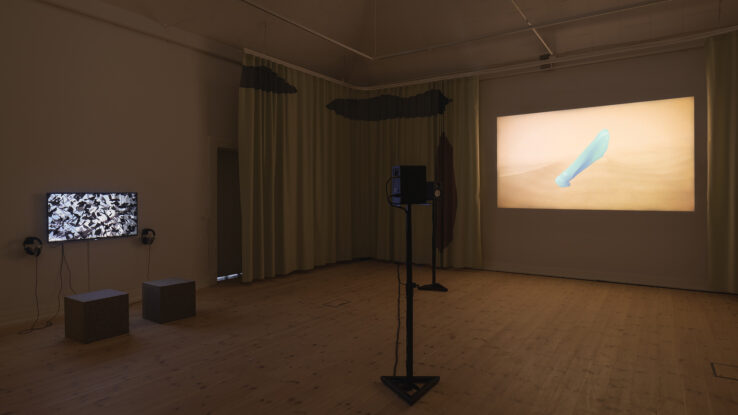
Piscine (Jens Settergren, Mark Tholander og Anna Ørberg)
Title: OS (2019)
Location: Gallery 1, Kunsthal Aarhus
OS is a video work exploring an operative system where infrastructure sets up the limits for what is possible. With long smooth camera movements referring to surveillance, information technology and the remote warfare of today, the recordings show us spaces devoid of humans, populated instead by familiar figures/characters from the world of fiction. As if they were bugs in a computer’s operative system the figures seem unwanted and all try to hide away or disappear completely, when we come closer. Shaped as 2D-animations, the characters perpetually behave in an ambiguous manner in the claustrophobic and monitored environment, and it remains unclear whether they themselves are formations of power structures, or represent strategies for the deviation from established structures.
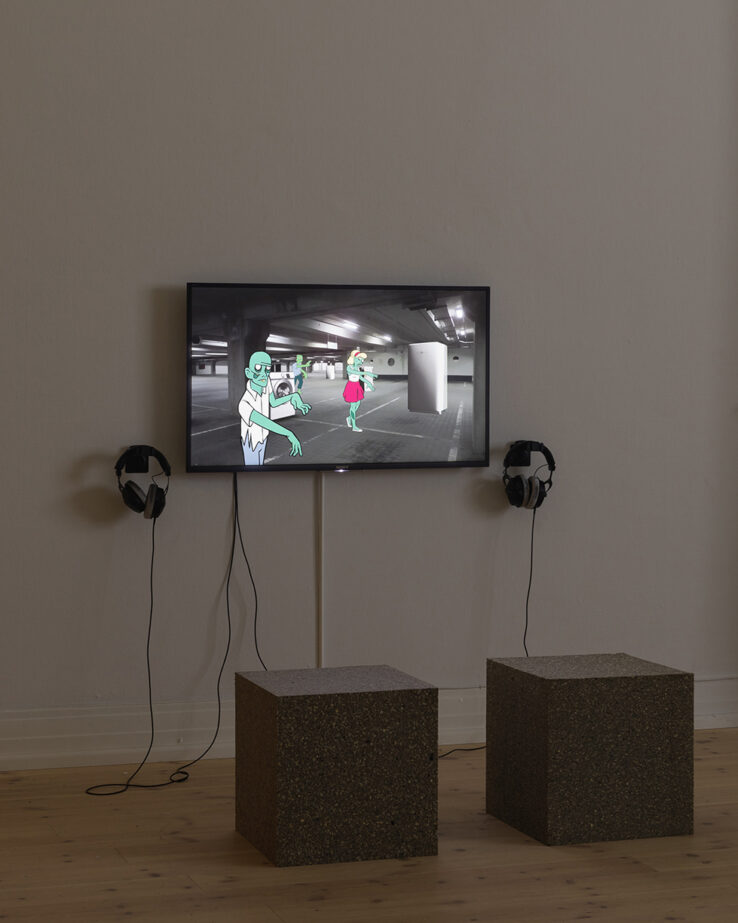
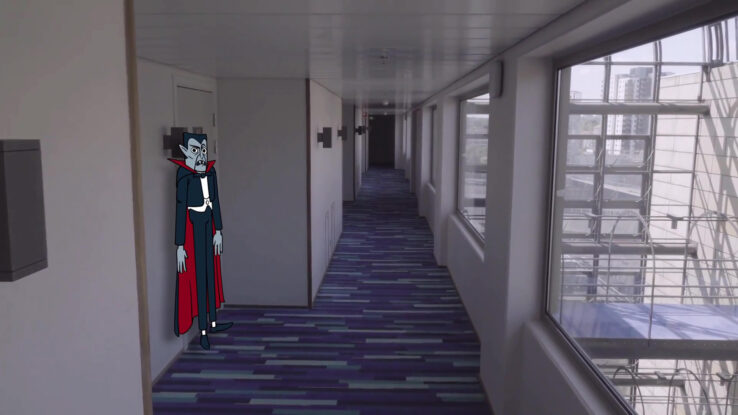
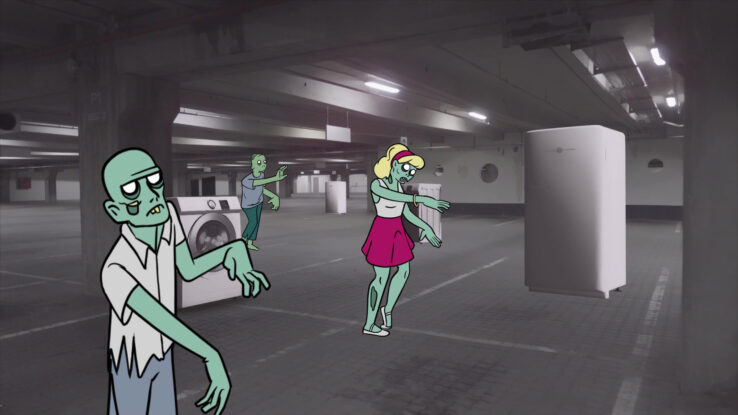
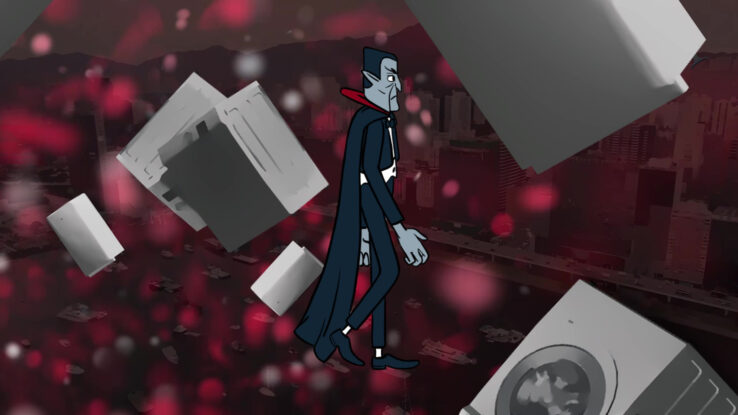
Maximilian Schmoetzer
Title: Not Love Alone (2019)
Location: Gallery 1, Kunsthal Aarhus
Not Love Alone narrates a fragmented history of an ibis bird, which is introduced alongside the replica of the arch of Palmyra. The original arch was blown to pieces by ISIS in 2015. Sharing affinity with the circulatory power of the poor(-3D-printed) image, the facsimile arch was publicly flaunted in cities like London, New York, Dubai, and Washington DC. The Syrian colony of this ibis bird became extinct at the same time and moment of political rupture as the arch was destroyed— the geopolitical and the ecological crossed paths and went awry. The very last ibis bird in Syria was a female named Zenobia, after the last queen of Palmyra, by the people who were tasked with its conservation, however, their efforts were in vain. While the actual ibis colony did not survive, a vagrant pop-up arch of Palmyra has been brought back to life through a face-lift gone wrong. Assembled, dismantled, shipped, and reassembled again, all with the ease of dealing with an oversized toy. By interlocking both the arch and the bird, Not Love Alone embarks on a migration in which virtual (re)creation and physical materialization, historical references, and recent events coincide.
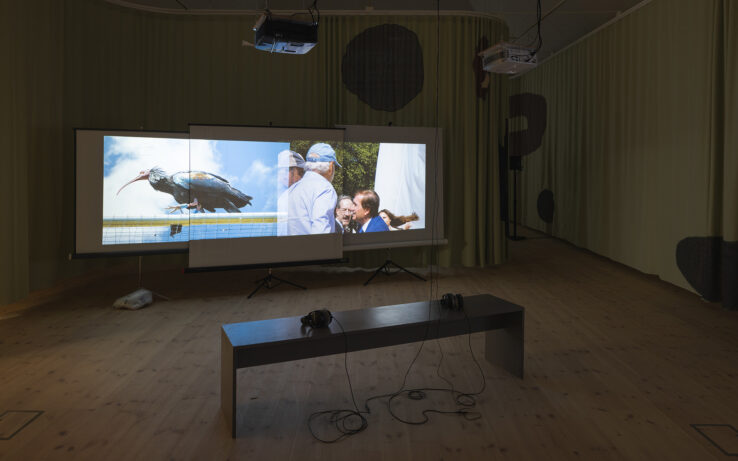
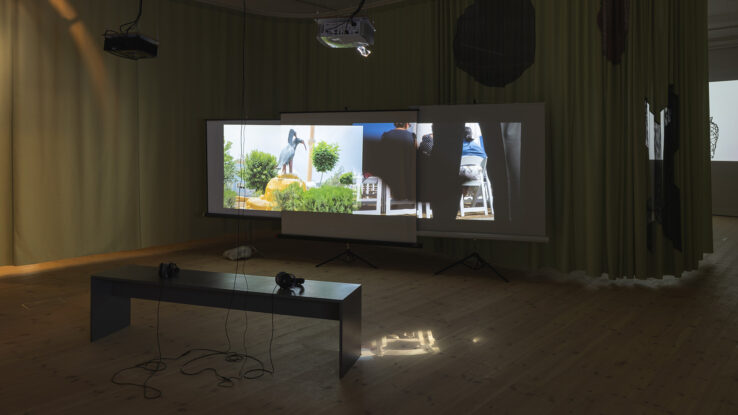
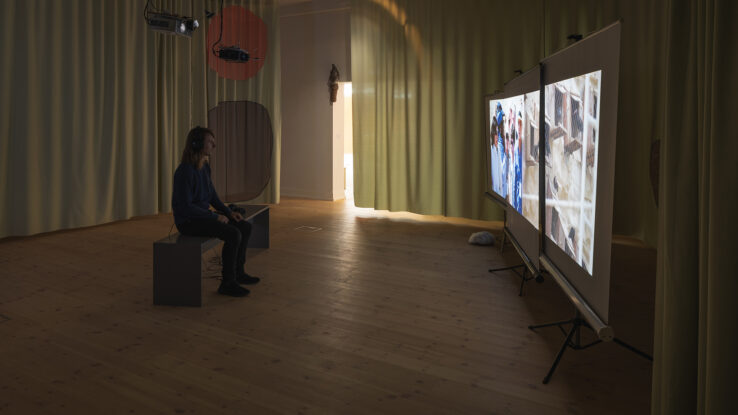
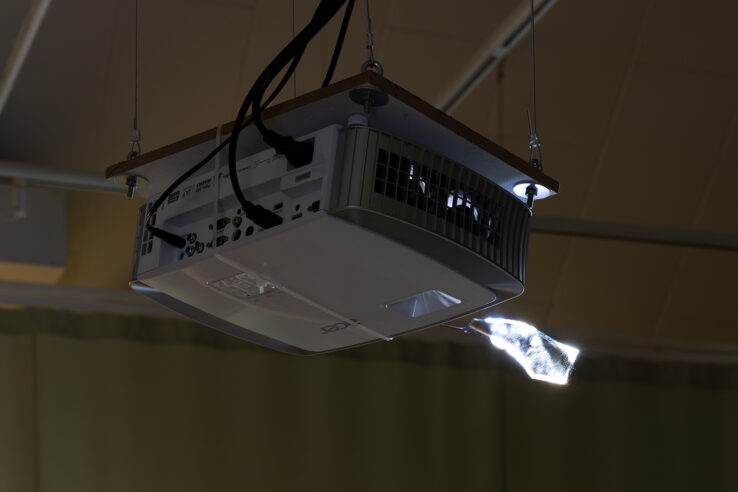
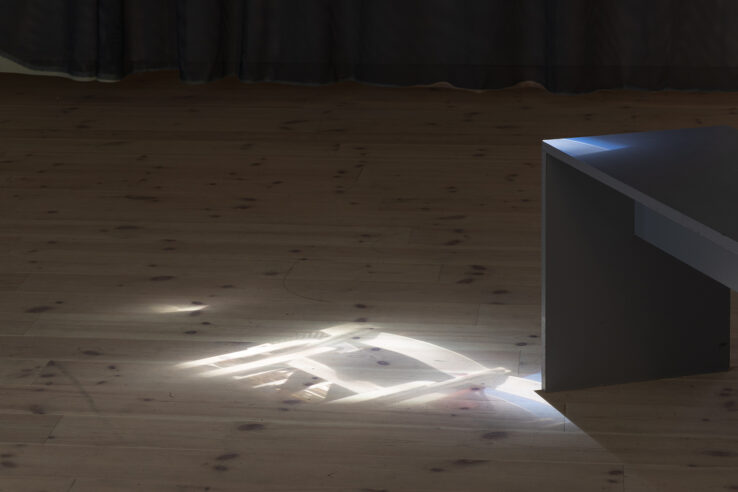
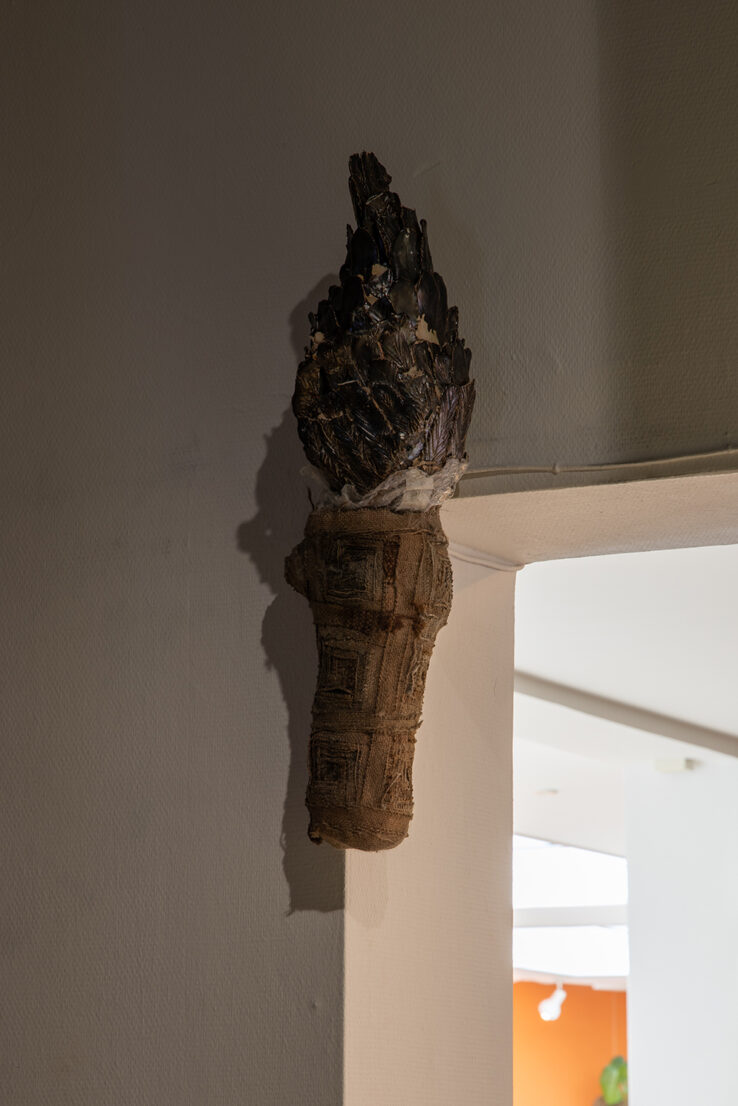
Linda Karin Larsen
Title: A New Value System With Images and Symbols That Connect Us to Each Other and to The Planet: Dwell Among Water Spirits (2019)
Location: Gallery 1, Kunsthal Aarhus
Linda Karin Larsen presents a video work, featuring members of her family. She investigates the presence of her Nigerian Ijaw and Norwegian ancestors, the experience of floating in the middle ground between two cultures, and the mythological influence of water in both cultures. Her Nigerian mother moves through Norwegian water landscapes. She grew up swimming in the rivers of the Delta State, among crocodiles and water spirits. Her brother performs Black Fu in the ocean. He uses these motions to introduce new perspectives on ways to connect his body to the water. An act of resistance. In several situations, he has had to use the knowledge of these movements, to defend himself from physical attacks from neo nazis. In addition, Linda’s own body sails above the sea and emerges from water. Water spirits and Mami Wata are essential in the beliefs of the Ijaw. In Nigeria, devotees of Mami Wata typically wear red and white clothing, as these colors represent Mami’s dual nature. From concepts like The Great Chain of Being, a hierarchical structure of all matter and life, to Descartes dichotomy between unthinking matter and thinking mind, Larsen wishes to step outside the current of Western philosophical tradition and instead enter into a stream of thoughts and traditions that unifies water, plants, animals, bodies, mind and soul. Water represents the unified presence of the disparate ancestors of Larsen, as she sees water as that which connects her different cultural backgrounds, across time and space, from the near to the elsewhere.
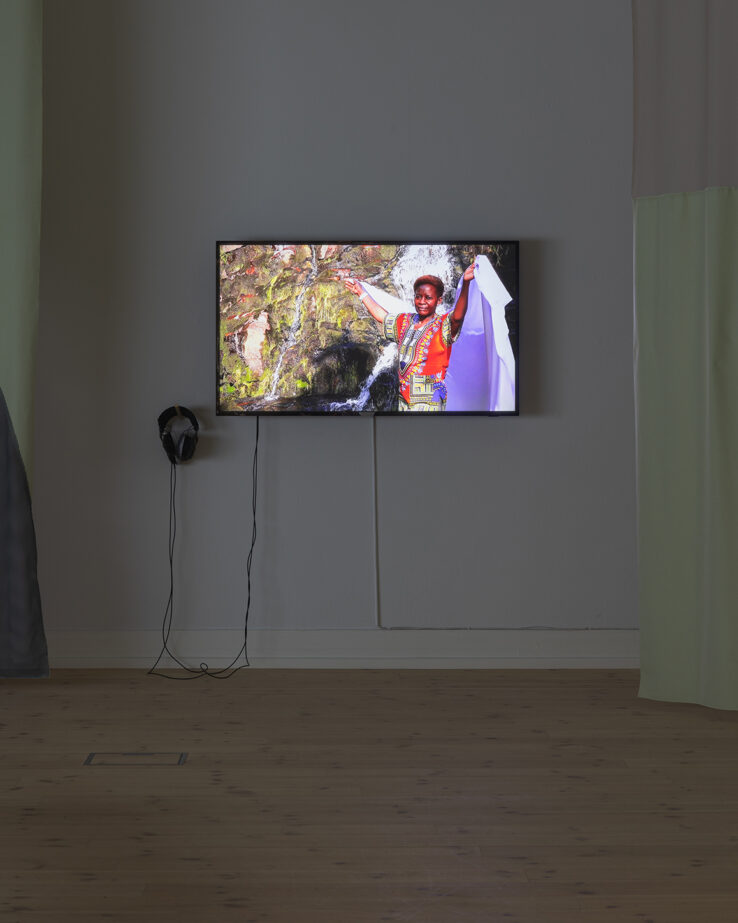
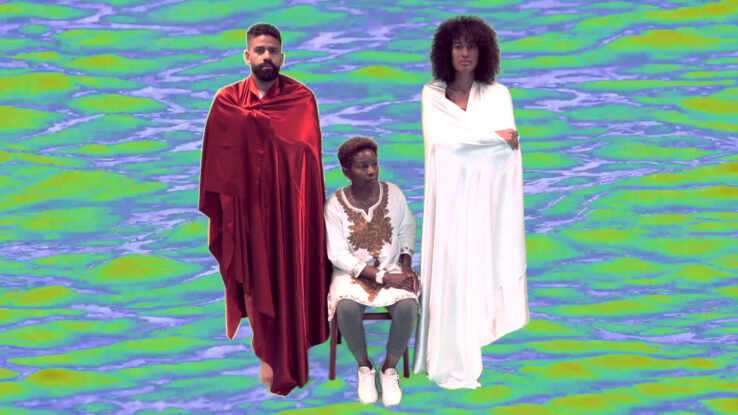
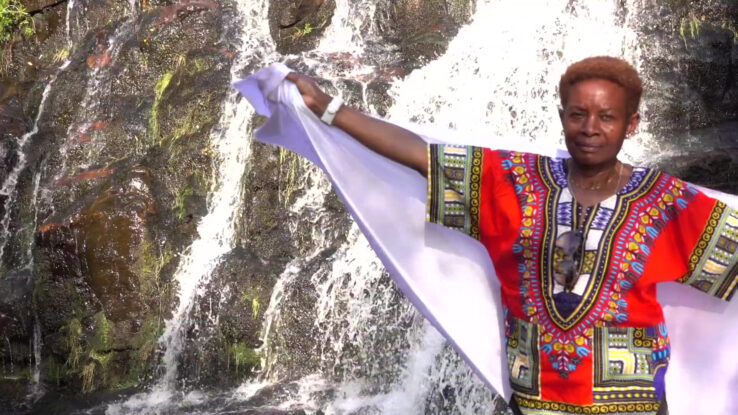
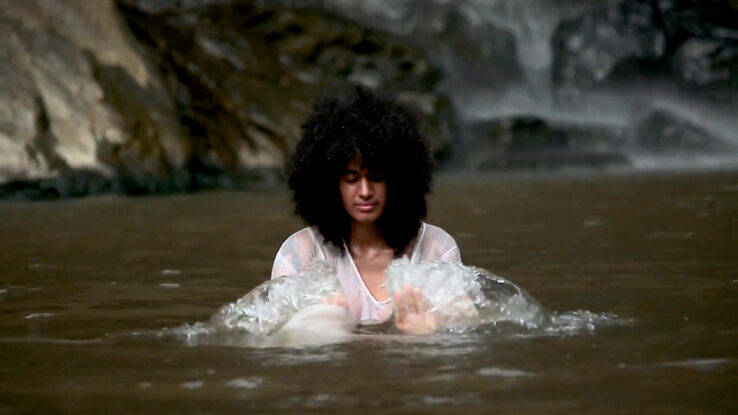
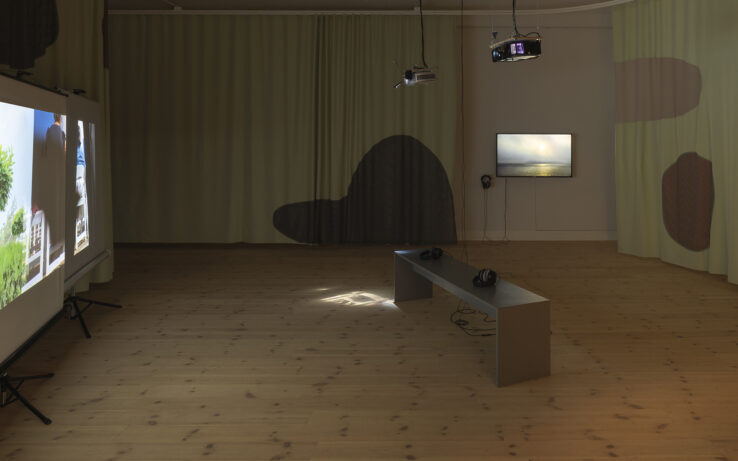
Sofia Duchovny
Title: Fountain (voll im Leben) (2019)
Location: Sculpture Garden, Kunsthal Aarhus
With the rediscovery of Roman texts on architecture and hydraulics, an early Renaissance trend, fountains rose beyond the decorative and became demonstrations of social decorum and power – splurging, shaping, controlling the vital element of water. A status still on display in central marketplaces, tacky hotel lobbies and modest garden plots. Based on the artist’s interest in using water as a material which is ’’temporarily in place“, Sofia Duchovny presents a foldable and transportable fountain, reminiscent of her earlier tent-sculptures. The lightweight construction can be installed almost everywhere, gaining weight and momentum by the added water, turning any place into a site. By citing and reenacting the spectacle of looped water, yet choosing a provisional, mobile structure that lacks the claim of perpetual power, Duchovny’s sketch-like fountain offers plenty of space for the romantic and the comic to drip, squirt and run through its structures.
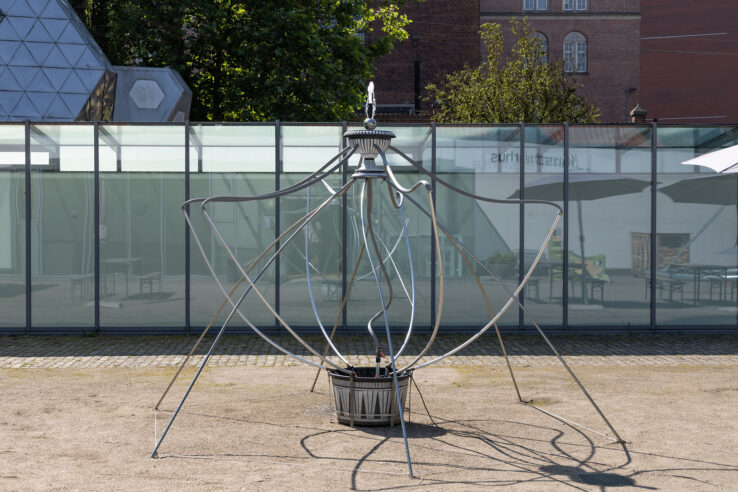
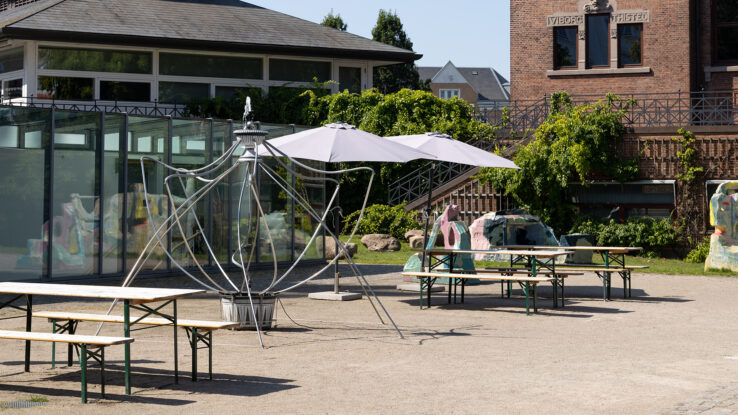
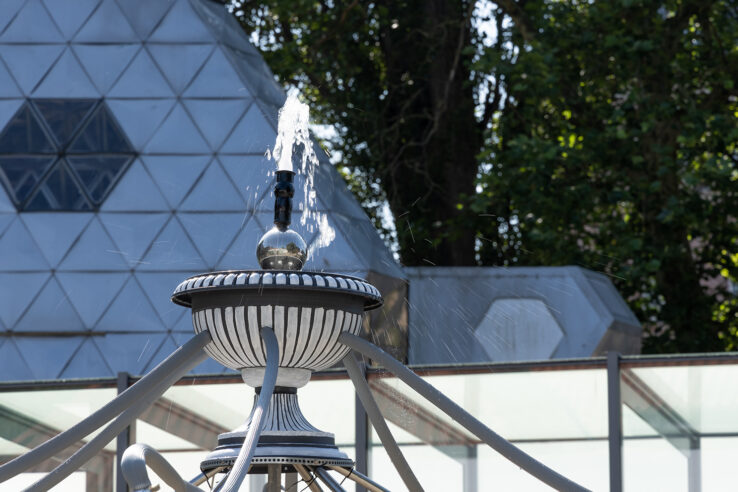
Aeron Bergman & Alejandra Salinas
Title: Burned Little Trees™ (2019)
Location: Sculpture Garden, Kunsthal Aarhus
In 1952, a chemist and perfumist named Julius Samann drew up a United States Patent and Trademark Office application for a “container of volatile substances” and submitted it in 1954. On August 7, 1956, he was granted patent number US2757957. The Little Trees have become very familiar: Car-Freshener Corporation over the years has sued Old Navy, Rite-Way, Urban Outfitters and others for violation of patent.In the park of Kunsthal Aarhus Bergman & Salinas present Burned Little Trees™, a series of the burned air fresheners, in Europe licensed and sold as Wunderbaum. These fire-ridden wonder-trees, displaced from the car windows they usually inhabit, must now compete with the variety of smells in their new habitat.
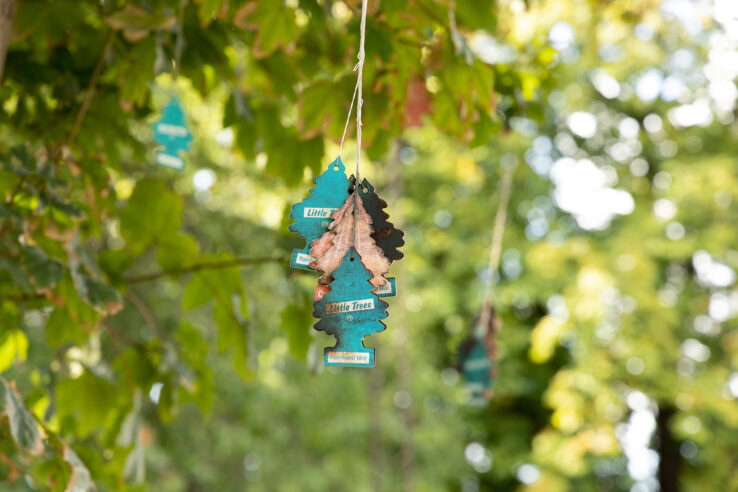
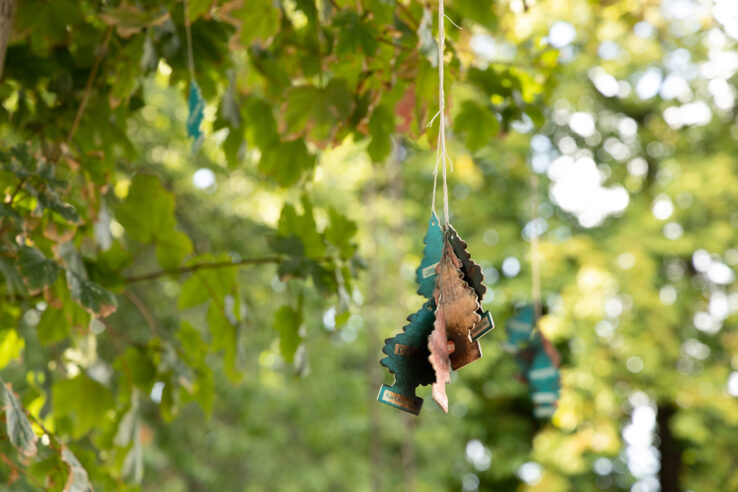
Henriette Heise
Title: The Flanet (the flat planet) (2019)
Location: Sculpture Garden, Kunsthal Aarhus
Henriette Heise’s flat planet has landed in Kunsthal Aarhus’ Park. Settled on the grass between the main building and the two globe finials that mark the entrance to the park, The Flanet lurks, grounded and brought low. It is a depressed sculpture. The Flanet can scarcely summon the energy to sufficiently act like a sculpture. It prefers to disappear, camouflaged behind the same coarse surface of trowel-thrown roughcast and paint as both the building and the globes. It prefers to drift about the park unseen, hoping to pass for just another globe, just another part of the Kunsthal’s familiar facade.With the arrival of Heise’s The Flanet, Kunsthal Aarhus has one more celestial body orbiting its system. However seemingly inconspicuous its presence, The Flanet’s appearance fundamentally shifts the cosmology. Things will never be the same again. The Flanet is related to The Depressed Planet. Both characters continue to make increasingly exhausted appearances in the work of Henriette Heise.
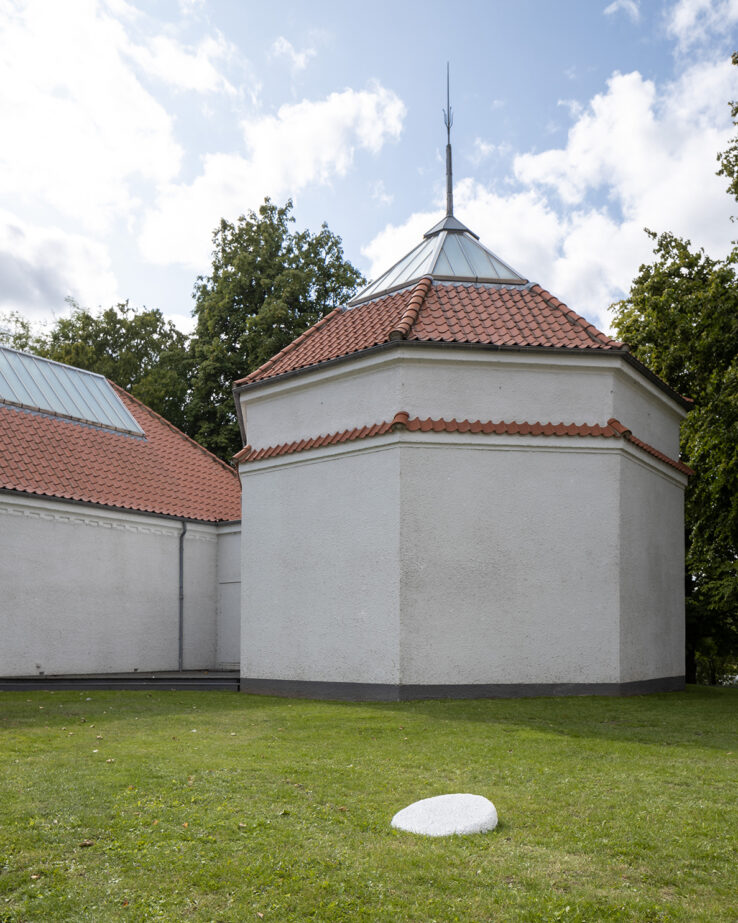
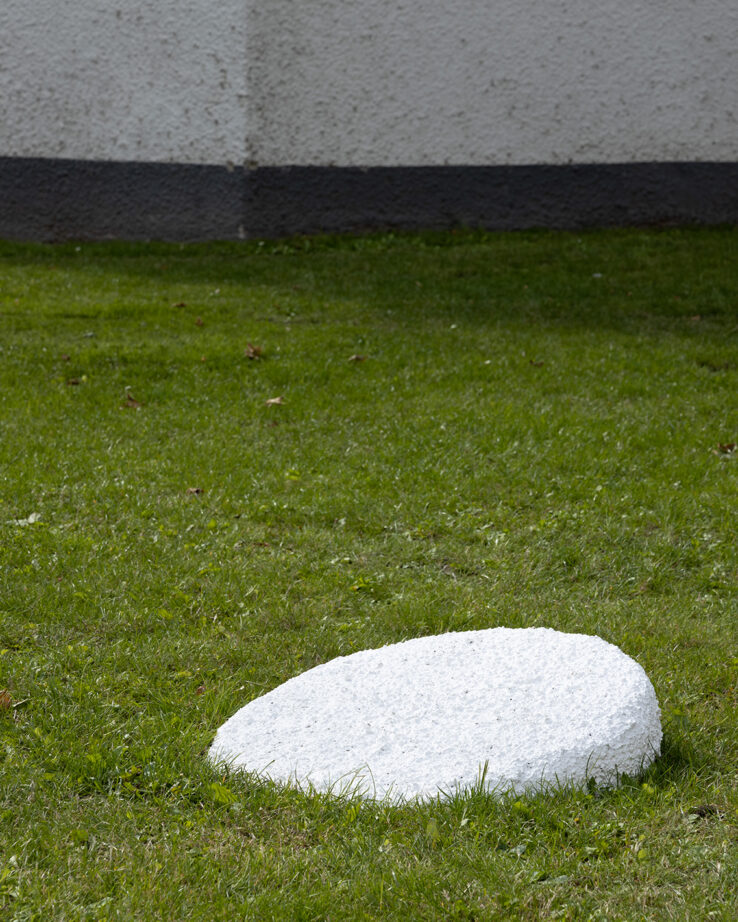
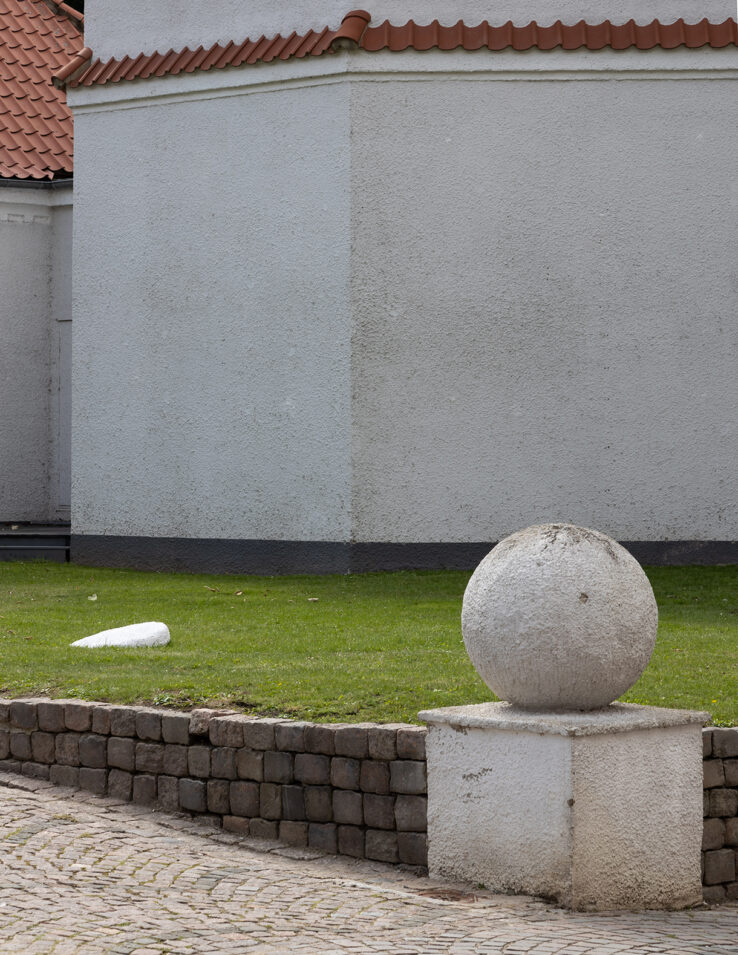
Rikard Thambert
Title: Natugle (2019)
Location: Sculpture Garden, Kunsthal Aarhus
The sculpture shows a young female human body in a floating position. An owl spreading its wings sits on the figure’s head. It seems as if the body is drawn upwards and is about to fly away with the bird. With its smile and its eyes peacefully shut, the human body, being the subject of the sculpture, is expressing an immense satisfaction with the situation. The body has a mild, forward-leaning and dreamy appearance – almost escapist. You sense the urge to finally get away, and feeling relieved breaking the bond with gravity.
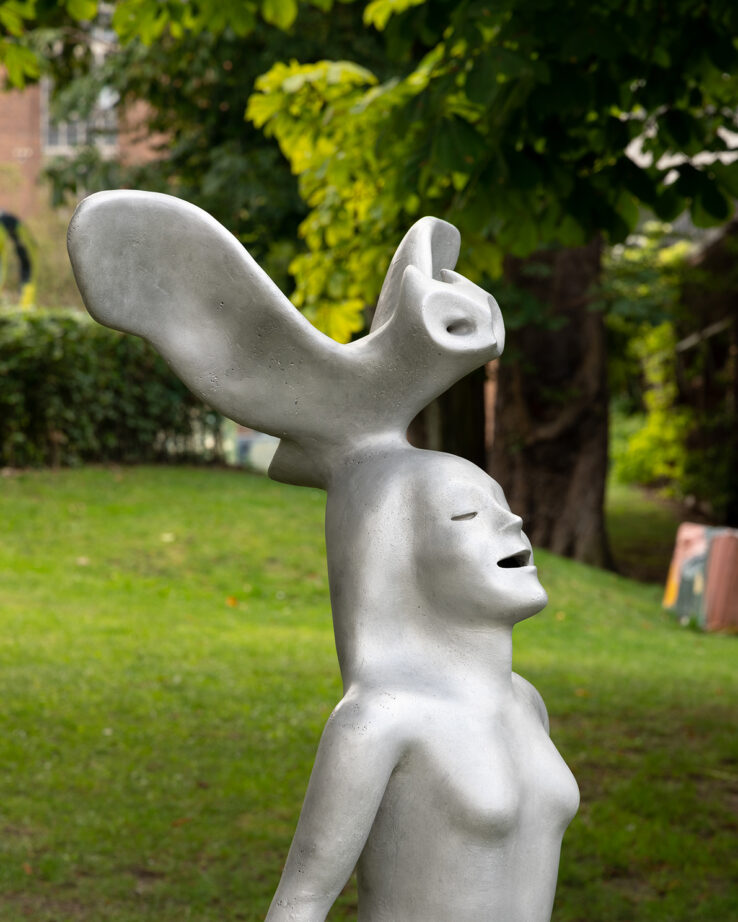
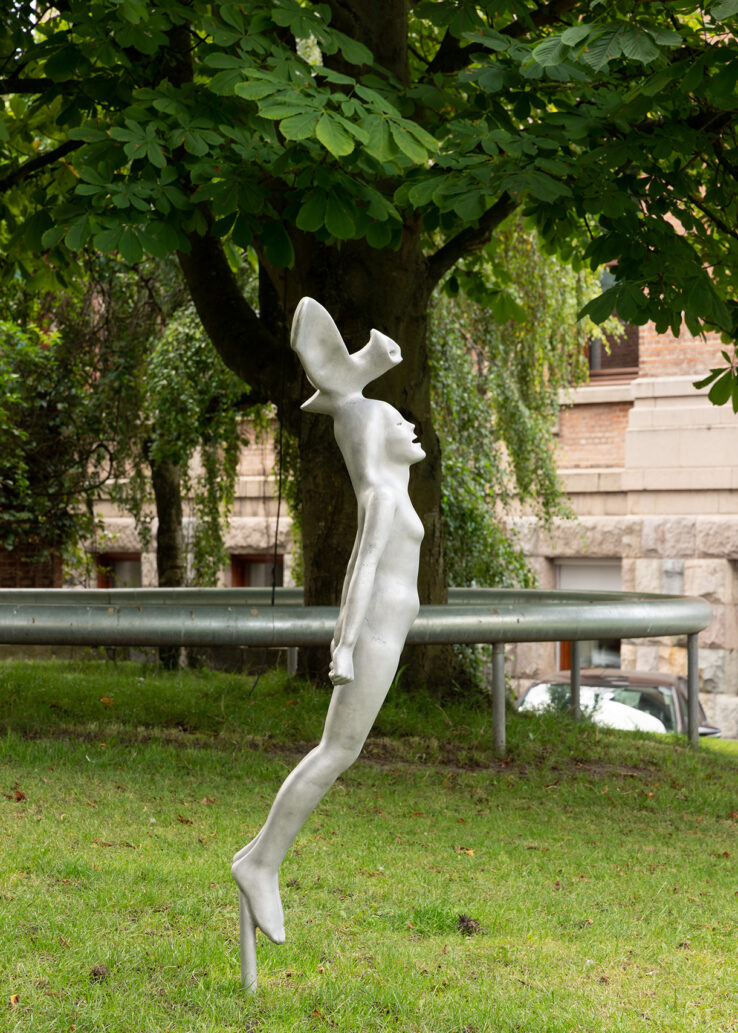
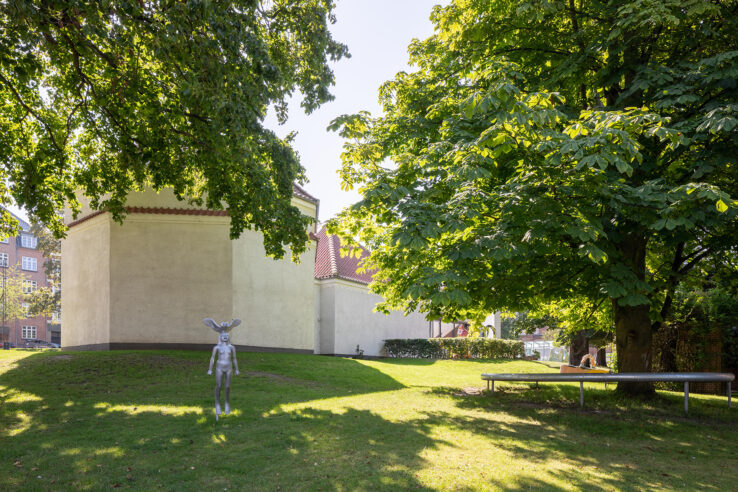
Aeron Bergman & Alejandra Salinas
Title: Loser (2019)
Location: Sculpture Garden, Kunsthal Aarhus
Loser is a sound piece developed by the artist duo Bergman & Salinas, and performed by Blueprint Choir in Portland, Oregon. The choir received the following instructions in place of a strict musical score: Please improvise with the refrain of Beck’s slacker hit song Loser. Play with the physicality of the notes. Sing alone, together. This recording is the 4th take. The symbolic use of choral singing to metaphorically represent a collective public is long-established. Bergman & Salinas chose to transpose Beck’s song because the concept “loser” is the all-important, necessary background image for the foregrounding of “winners” in the forced competition of the markets. Scientologist founder L. Ron Hubbard wrote You don’t get rich writing science fiction. If you want to get rich, you start a religion. It is perhaps just a coincidence that Beck is a Scientologist as well as a popstar. L. Ron Hubbard may have been referring to the creative economy when he said: A culture is only as great as its dreams, and its dreams are dreamed by artists.
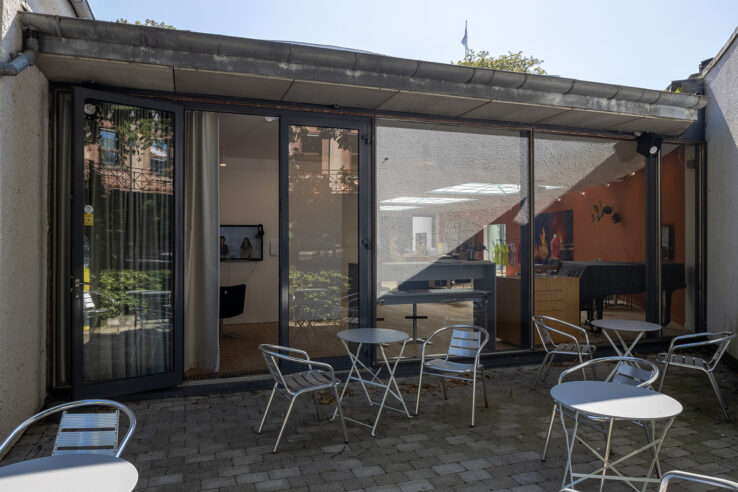
Richard Frater
Title: Stop Shell (ghost fishing version) (2018)
Location: The Greenhouses in The Botanical Garden
Stop Shell (ghost fishing version) is a sculpture that houses a jacket constructed from recycled plastic waste materials recovered from the ocean. The jacket has been modified to emulate a crayfish trap. It explores the example of ‘ghost’ fishing nets that are left or lost in the ocean as a result of commercial fishing. These nets are non-biodegradable and continue to fruitlessly trap fish long after their initial use has been expended. The work explores the adjustments and responses of consumer culture to the anthropogenic impact of plastic pollution, otherwise known as environmental breakdown.
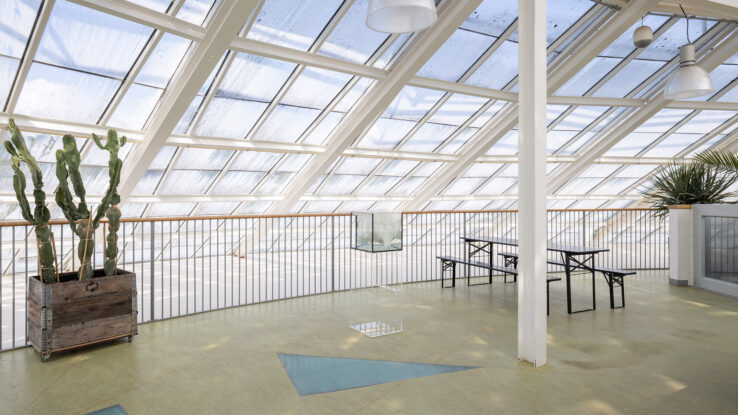
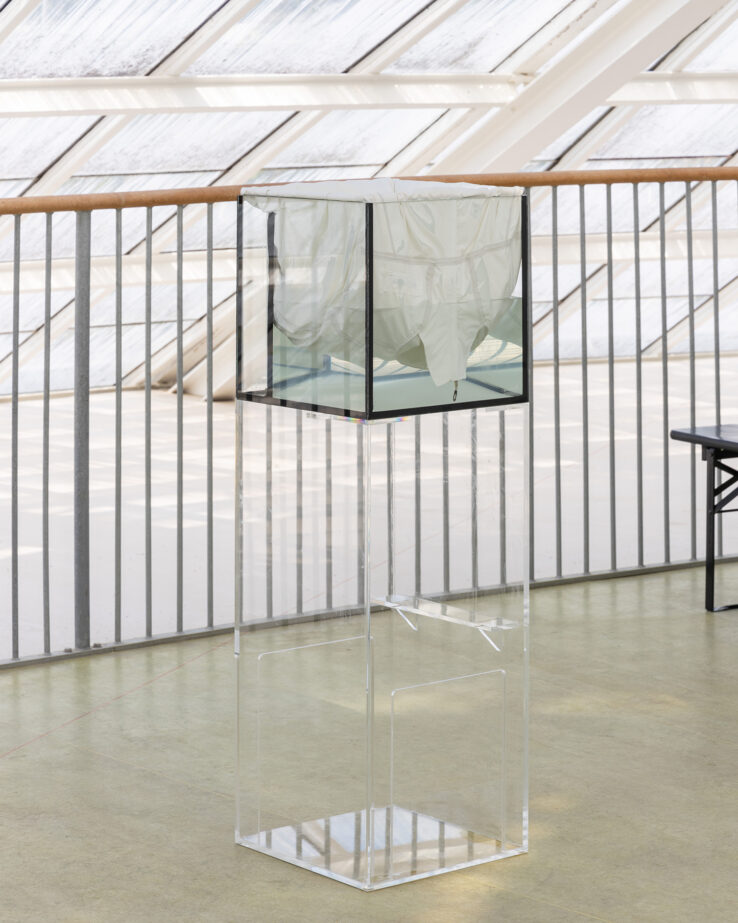
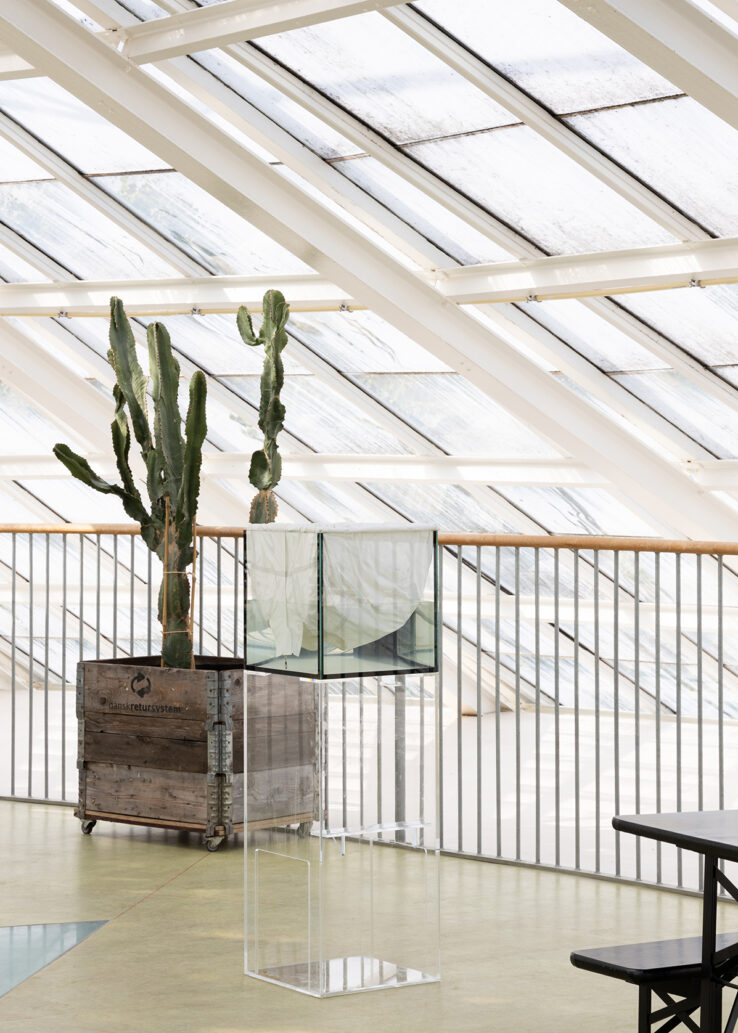
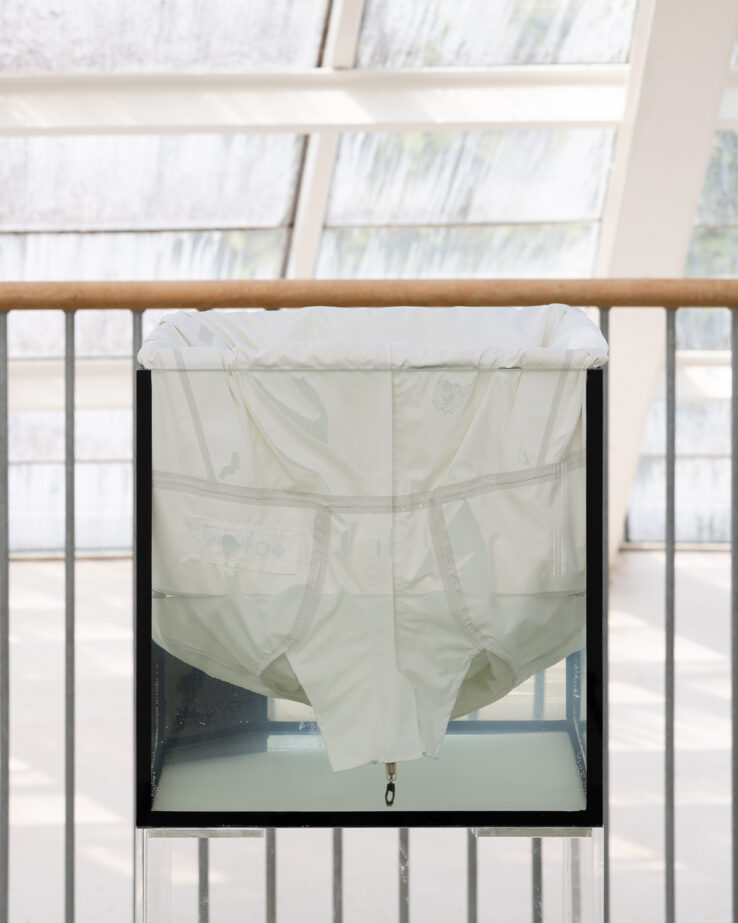
Maximilian Schmoetzer
Title: Me and you (2018)
Location: The Greenhouses in The Botanical Garden
Me and you is a modified wildlife observation camping chair. Maximilian Schmoetzer has placed the chair inside a plastic dome, emphasizing the relationship between the interior and the exterior. There is a sense of irony in the outdoor gear, intended for experiencing nature at close range, while positioned within an artificial membrane, that might offer cover and safety, but most of all distances and alienates the observer from its surroundings.There is a plot twist in the fact that the viewer is observing the observation chair – and not the other way around, further adding to the confusion regarding who is the subject and the object. The title Me and you insinuates a union and demarcation of the observer and that which is being observed. In this context, the work questions the role of the gaze in nature as well as culture, and maybe even offers an obliteration of the binary and oppositional relationship between such untenable concepts. Still, it remains obvious that there is a resistant boundary between these elements, as the chair sits desolate, uninhabited, appearing almost alien in its isolation.
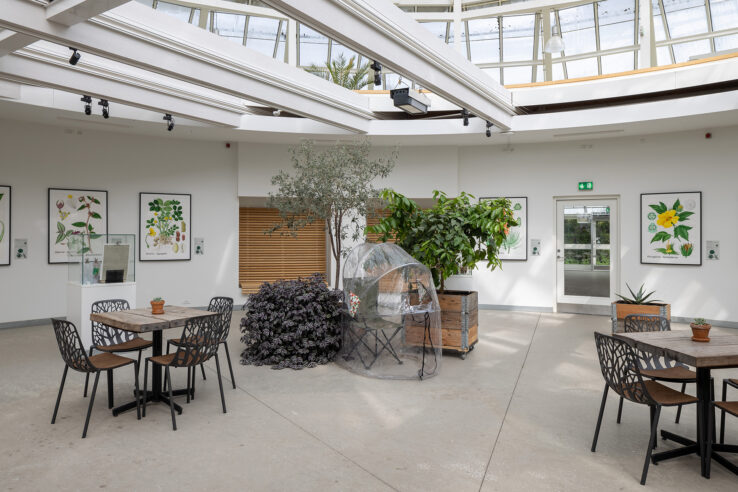
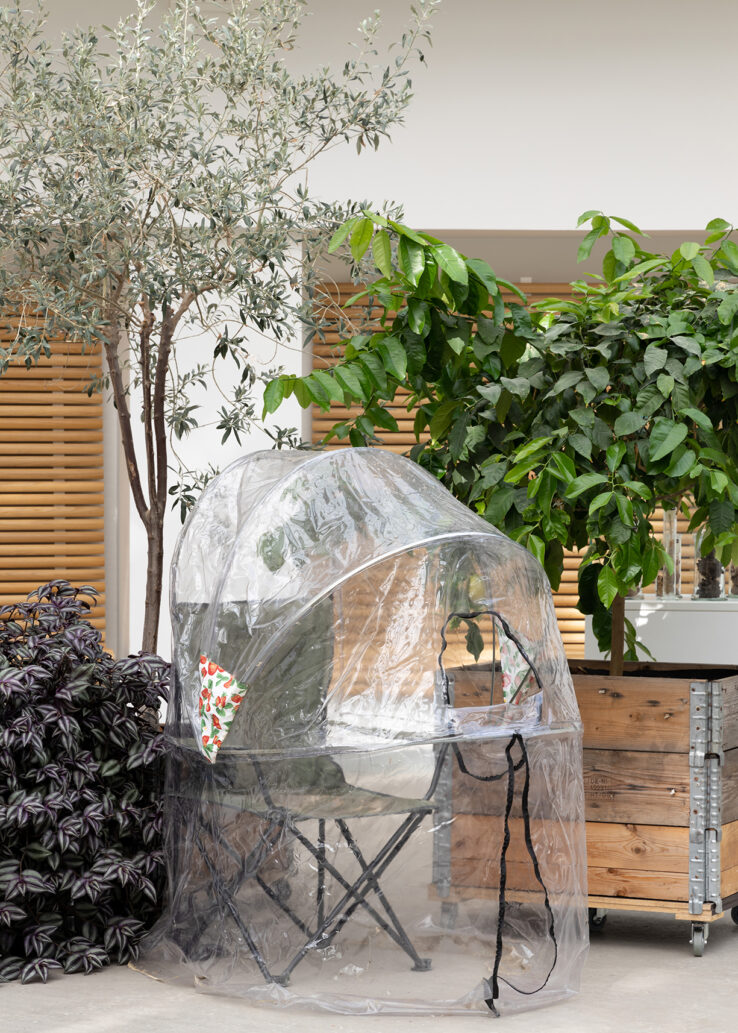
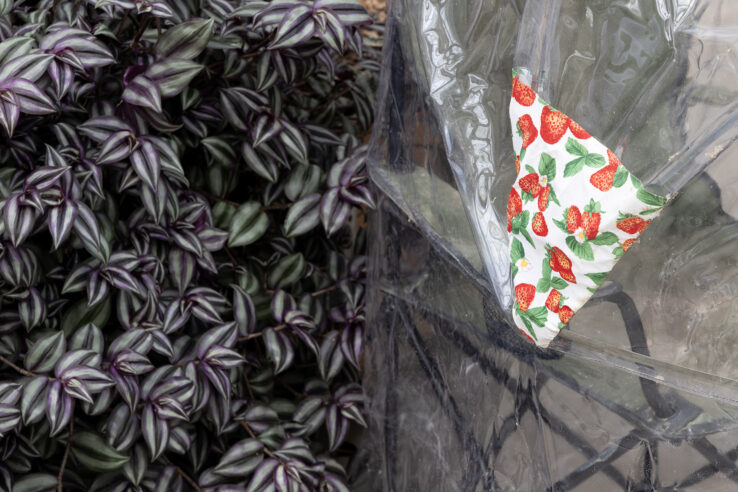
Peter Land
Title: Falling Fruit (2018) & Ladies Night (2018)
Location: Radisson Blu Hotel
The concept of the non-place, introduced by Marc Augé, describes anthropological spaces where the human remains anonymous. Augé describes non-places as spaces of circulation, consumption and communication, and gives as examples airports, highways and hotel chains.The two works Falling Fruit and Ladies Night by Peter Land are dealing with the hotel chain as a non-place. The video work Falling Fruit presents an endless line of stock footage showing fruit falling into a fish tank. At first glance it could be a commercial, but looking closely the perpetual repetition of the same motif getting nowhere, reveals that there is something else on the line. Falling Fruit is shown in connection with Ladies Night, a kind of objet trouvé: a fruit cart filled with apples and a neon sign. The apples in the cart are fake and thus refer back to the artificiality shown in the video, where the fruits, more than being something edible, are a visual experience. The apples are drifting between being objects and non-objects in the same way as the hotel drifts between place and non-place. By means of our culture the apples are also calling forth associations to the sexual.
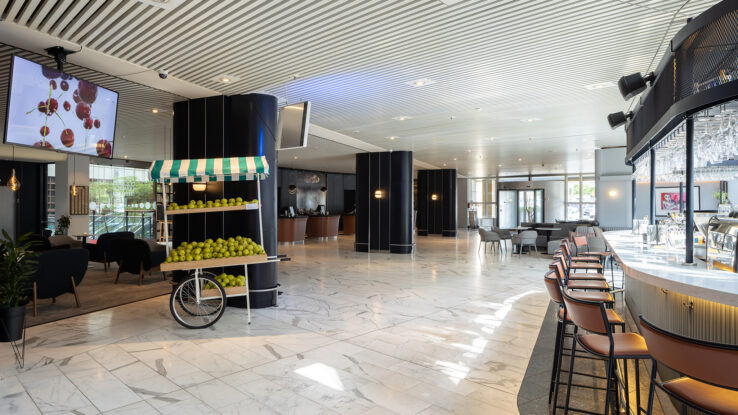
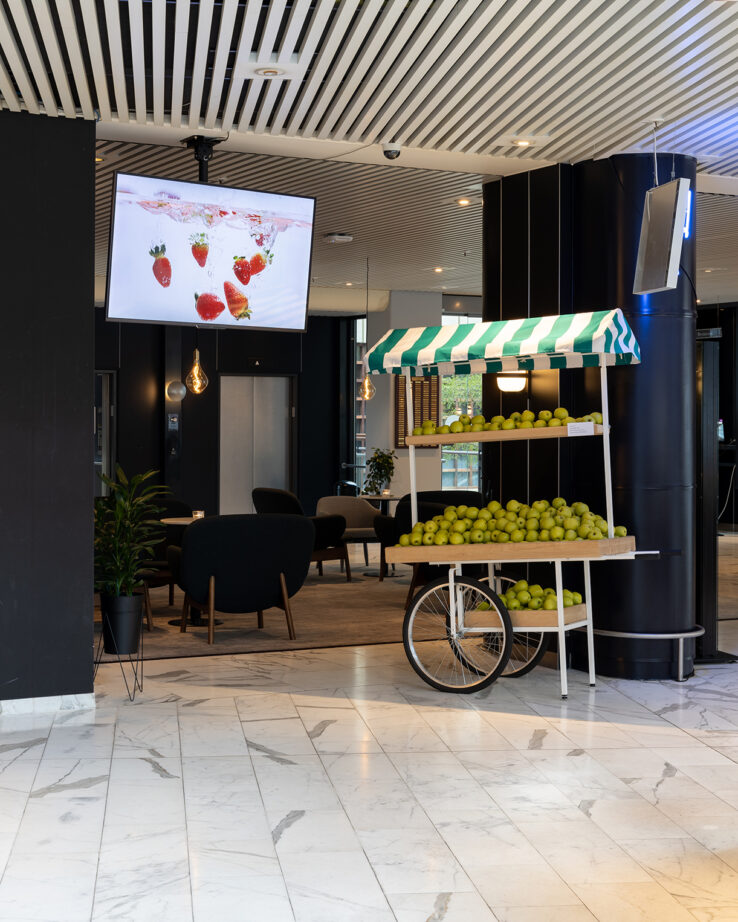
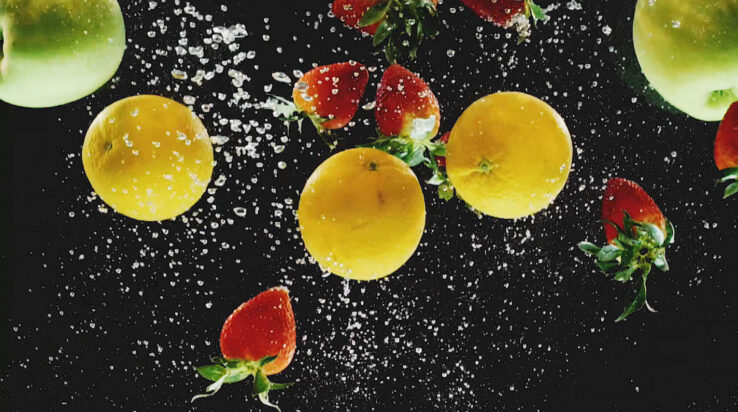
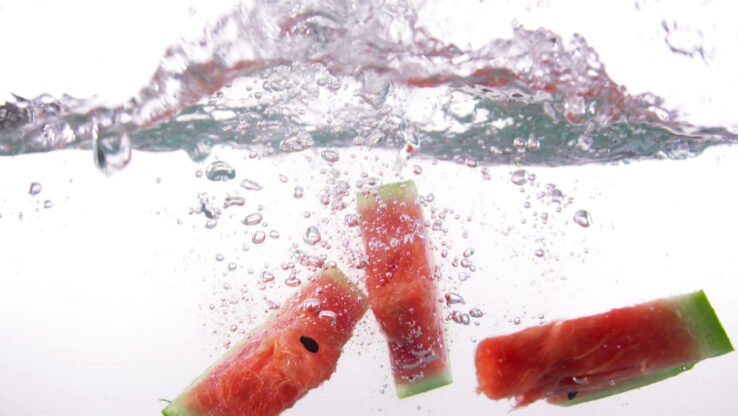
Pernille With Madsen
Title: Air-Pop (2019)
Location: Scandinavian Center
In Scandinavian Center you find the video installation Air-Pop between the two fountains on the centre’s staircase. A commodity and its packaging have mutated into a new hybrid product composed of flat screen and Styrofoam. The packaging has transferred its analogue body of air and plastic to the screen which is miming its own image – “screen with snow” – as a nostalgic re-enactment of itself. It is the device’s own statement: a non-man-made message of atmospheric noise. In the work we are floating through space on an ordinary Sunday in a closed center. The installation is a mix of analogous and digital visual effects and ends up somewhere between reality and abstraction – a coincidence of bodily scale and pure proportions, where the eyes can wander between the two; between the tangible and the imaginary.
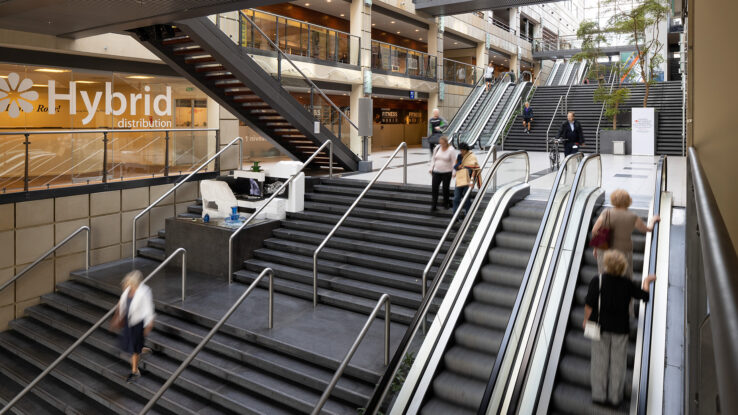
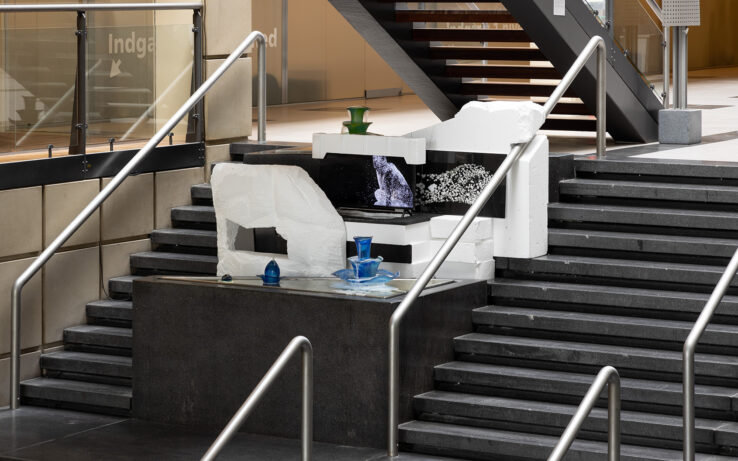
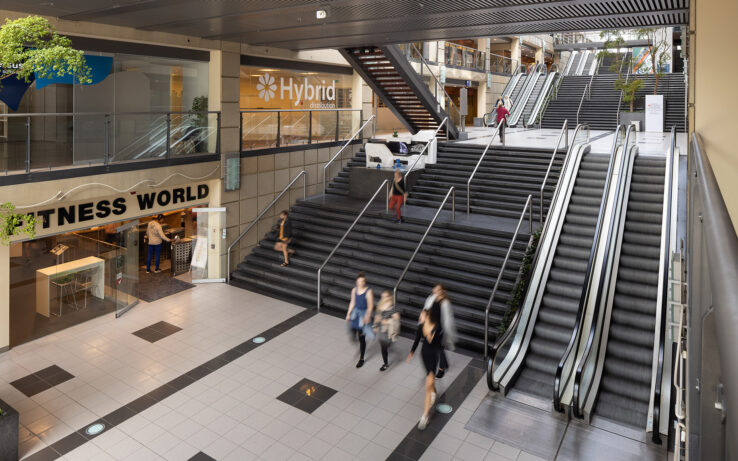
Jørgen Michaelsen
Title (Installation): Dosis (2019)
Title (Publikation): Dosis. Jørgen Michaelsen og den lovmæssige kunst. (2019)
Location: Aarhus Police Station (Installation) & Antipyrine Bookstore, Kunsthal Aarhus (Publication)
Jørgen Michaelsen presents a work manifesting itself in two media in parallel. Firstly, the wall installation Dosis that is exhibited in the reception area at Aarhus Police Station. Secondly, the publication Dosis. Jørgen Michaelsen og den lovmæssige kunst, published by Antipyrine.
Dosis is probably best described as ‘meta-interventionist’, meaning that the wall installation should not be taken as ‘artistic-political counterbalancing’, but rather as a an intervention dynamically and reflexively addressing itself as an intervention, thus making the work raise issues on cultural justification.Dosis operates on different levels, but is as a whole engages as an explicit gesture in the reception area at Aarhus Police Station: an impetuously tangled foreign object of aesthetics, signs and historicity placed in a psychosocial latent zone.
The publication Dosis. Jørgen Michaelsen og den lovmæssige kunst contains a dialogue of 9 participants, developing into an oscillation between the esoteric and the exoteric, between the ‘hermetic’ or inaccessibilized and the widely appealing. Although the subtitle may indicate it, the book is not treating the actual works of Jørgen Michaelsen, rather, it seems that his practice is taken ‘hostage’ in some kind of debating drama. Dosis and Dosis. Jørgen Michaelsen og den lovmæssige kunst can thus be regarded as two different approaches to the same fundamental problematic, making it unclear what position one medium is given against the other.
